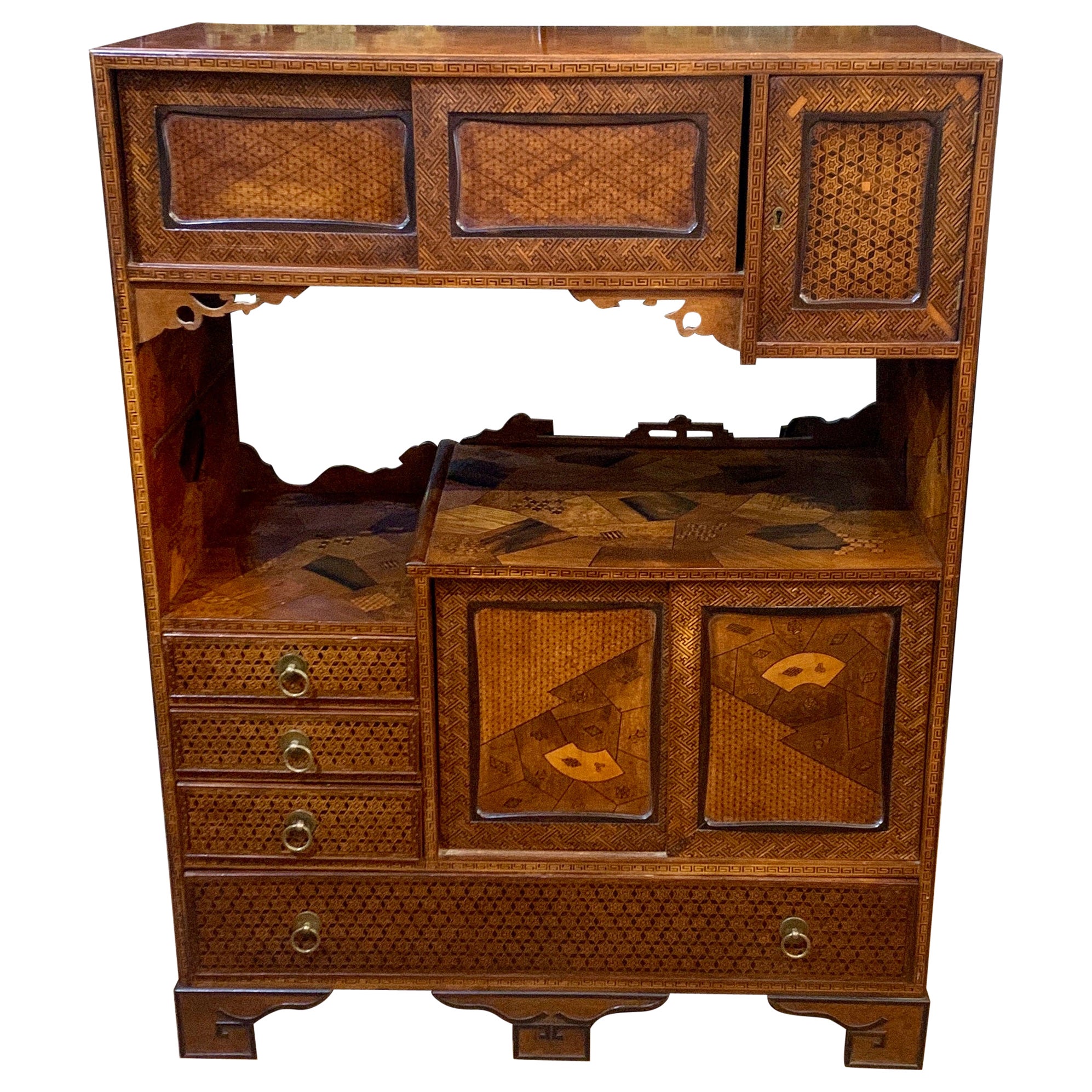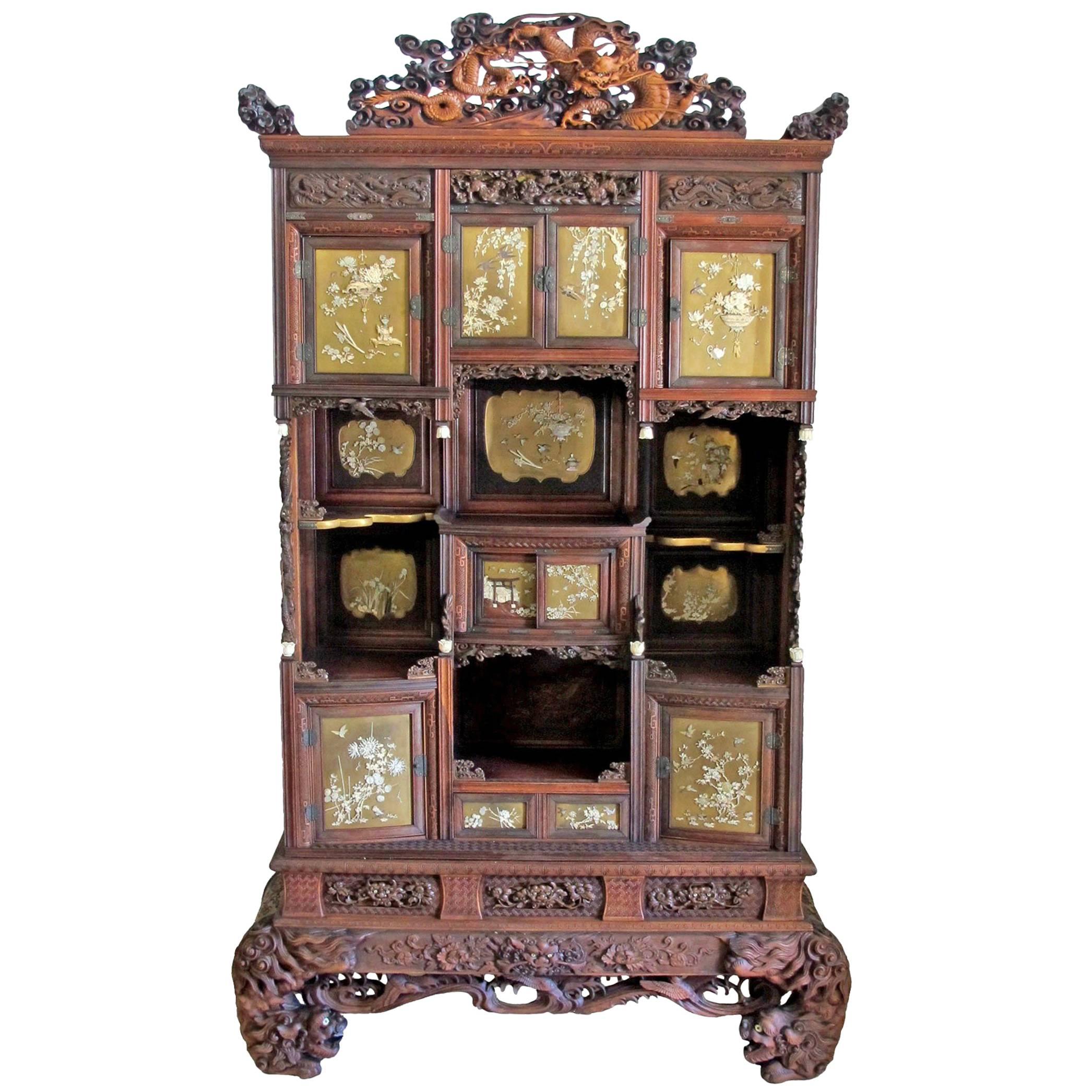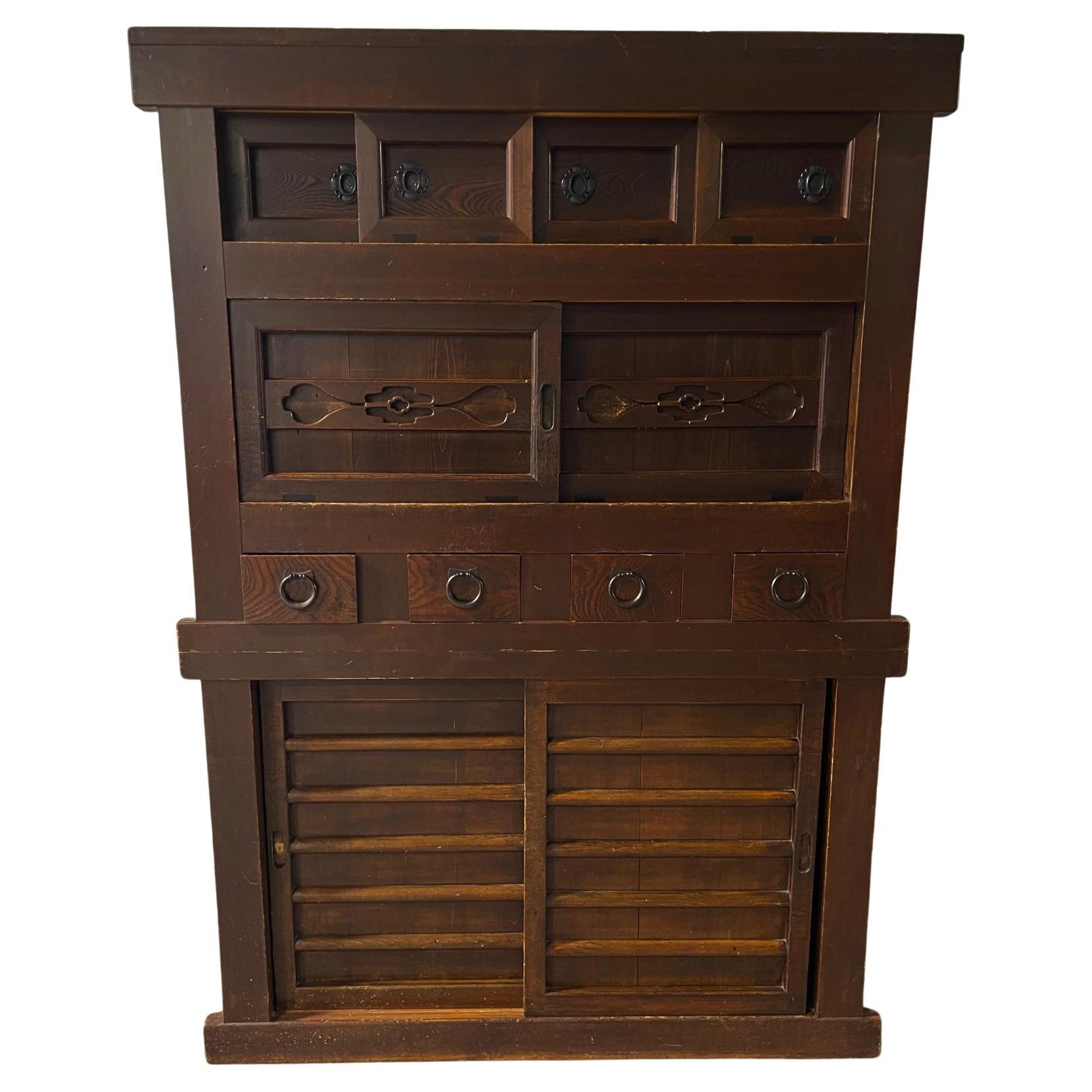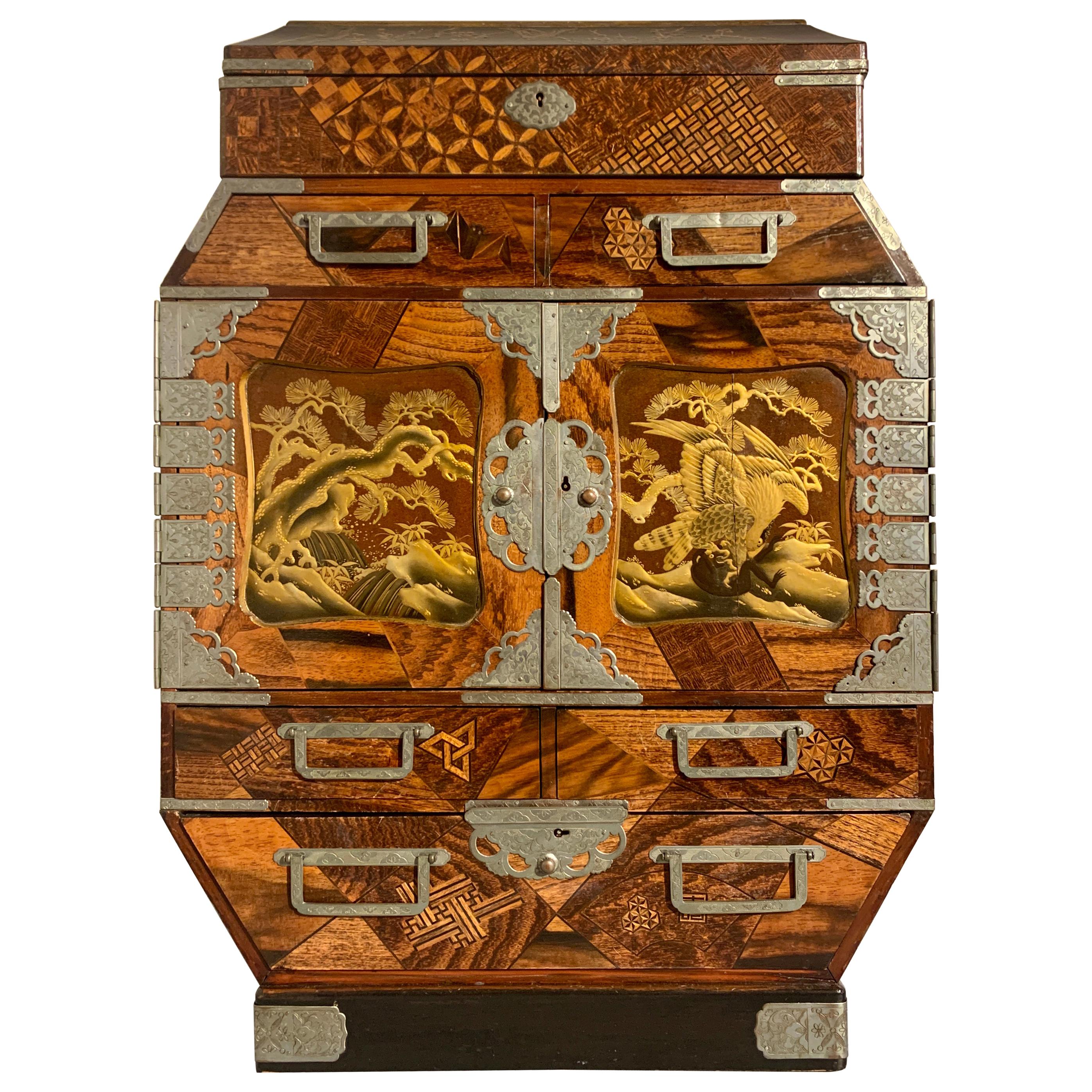Items Similar to Fine Japanese Portable Tea Cabinet Meiji Period with Provenance
Want more images or videos?
Request additional images or videos from the seller
1 of 18
Fine Japanese Portable Tea Cabinet Meiji Period with Provenance
About the Item
An antique Japanese portable cabinet finely fashioned out of Sandalwood, a fragrant and also one of the most expensive woods that was used to make small luxury pieces. The handled cabinet was stained in a deep reddish color and has a very modern silouette with two slightly upturned ends. The cabinet accommodate an assortment of four drawers of various sizes and shapes. The back has finger holes which was designed to help opening the drawers without any handles or pulls. The construction shows exposed finger and through-tenon joints. The drawers were jointed together with tiny wood nails, no metal was used.
The cabinet exhibits fine wood craftmanship. It retains an original paper label from The Takashiyama store in New York City (1958-2010). It states that it was made from sandalwood and used to contain and transport tea utensils. It further dated the piece to 1910s, the end of Meiji Period.
- Dimensions:Height: 12.5 in (31.75 cm)Width: 12.5 in (31.75 cm)Depth: 7 in (17.78 cm)
- Style:Meiji (Of the Period)
- Materials and Techniques:
- Place of Origin:
- Period:
- Date of Manufacture:1910s
- Condition:Wear consistent with age and use. Fine condition with light age-related patina. A stable separation line along the right side of the backing plate, not visible unless turned around. A couple of wood split on the interior base of the drawers. Interior very clean.
- Seller Location:Atlanta, GA
- Reference Number:1stDibs: LU945038696212
About the Seller
5.0
Platinum Seller
These expertly vetted sellers are 1stDibs' most experienced sellers and are rated highest by our customers.
Established in 2006
1stDibs seller since 2010
479 sales on 1stDibs
Typical response time: <1 hour
- ShippingRetrieving quote...Ships From: Atlanta, GA
- Return PolicyA return for this item may be initiated within 2 days of delivery.
More From This SellerView All
- Fine Antique Tall Korean Medicine Chest Yakchang ProvenanceLocated in Atlanta, GAA fine antique Korean medicine or apothecary chest from late Joseon Dynasty (circa 19th century). Known as Yakchang in Korean, this type of chest was used to sort and store herb medicines in its many small drawers. The prototype was originated in China, but this piece is distinctively Korean. The fine piece was made from Paulownia wood, which has an insect-repelling quality. Relatively tall, the Yakchang features a slightly overhanging and upturning pagoda plank top. The upper part has ten rows of smaller drawers, eight per row and eighty total. The lower part is centered with double doors with brass hinges and pull that open to a small storage space, which is surrounded by twelve larger drawers. Each drawer is fitted with yellow brass pulls and with two names of the herbs in gilt Hanja writings. Examination of the construction and patina shows that this is an authentic antique piece that has seen extensive historical use. Provenance: Purchase from Lucky-Chosun Furniture, Seoul, Korea in 1986 and remains in an American collection until now. With an original invoice and also a freight invoice from Korea to Hongkong. There is also an insurance appraised by Sotheby's from 1997. A tall medicine chest with similar configuration from a doctor's home in Yongin Folk Village is illustrated on plate 75 page 61 in the book "Korean Furniture and Culture" by Bokcha, Soon and Youngsoon. To compare with another Medicine Chest, see illustration on page 47 in "Korean Antique Furniture...Category
Antique 19th Century Korean Other Furniture
MaterialsBrass
- Fine Japanese Ceramic Vase Makuzu Kozan Meiji PeriodBy Makuzu KozanLocated in Atlanta, GAA Japanese long neck porcelain vase circa 1900-1910s by the studio of Miyagawa Kozan (1842–1916), one of the most established and collected Japanese ceramist from the end of Meiji Period. Commonly known as Makuzu Kozan, which also appears as the signature on his work, his originally birth name was Miyagawa Toranosuke. He was the appointed artist to the Japanese Imperial household and his work was exhibited in many international fairs that the Meiji government participated at the turn of the century. This vase features an elegant Classic form with a slender neck and slightly flared mouth above a baluster body. It was finely painted with two swimming carps in a copper red underglaze among green ribbons like waves. The background display a brilliant verdant green overall, Around the fish a poetic hazy effect was emphasized for a visual complexity by Fuki-e (the blow painting), an invention in Kozan's studio. The new technical development of chemical colors from the west was embraced circa 1900s in Kozan studio. This empowered the more creative experiments with not only colors, but also concept of dimension, which led Makuzu Kozan's work to become a bridge between East and West aesthetics. This is particularly evident in this vase with the Masterly details of the brush strokes, the expertly employment of gradient of color, and a very realistic and detailed rendering of the fish and their vivid motions. For two similar examples of Kozan's work with similar carps decoration, see Page 148-149 of the book: Sekai ni Aisa Reta ya Kimono Miyagawa Kozan Makuzu...Category
Early 20th Century Japanese Meiji Ceramics
MaterialsCeramic
- Japanese Lacquer Box with Fine Maki-e Decoration Meiji PeriodLocated in Atlanta, GAA lacquered wood box with lid from Japan circa 19th century Meiji Period. The finely decorated box was used to store paper slips and small documents on the desk. It is overall finished with black lacquer (kuro) with sparse Mura-Nashiji effect outside and on the top surface of the lid, there are three Komainu, (sometimes known as Shishi or Japanese lions) frolicking and forming a circle in lively motion. Komainu are auspicious animals in Japanese cultures in both Shinto and Buddhism tradition. Originally from China, these animals symbolizes guardians to ward off evil spirits. Hiramaki-e was used in combination with carving and combing to render the lions with various surface textures. A gilt border with an slight angle was given to the lid and even the thin band is decorated with miniature floral scrolls. The interior of the box was finished in a dense nashiji. Underneath the lid, a cluster of peonies open lavishly by two gentle mounts. Takamaki-e (high relief) in both gold and silver were...Category
Antique Late 19th Century Japanese Japonisme Lacquer
MaterialsWood, Lacquer
- Japanese Table Cabinet with Cloisonne Panels in the style of Namikawa SosukeLocated in Atlanta, GAA Japanese wood and cloisonne cabinet circa Meiji period, late 19th-early 20th century. The small table top cabinet features a single drawer on top, four small doors with cloisonne panels on the second tier, a pair of larger cloisonne doors on the main level flanked by two skinny panels, and finally two drawers on the low level. It has a scroll carved base and sides as well four pagoda-shape cornices. The cloisonne panels were obviously the work of two different artist studios and were assembled on purpose to demonstrate a mixture of styles. The small top and the two skinny panels on the main level are of an earlier scrolling design that emphasize the wire work; The rest of the eight larger panels were done in a much later and painterly style attributed to Namikawa Sosuke...Category
Early 20th Century Japanese Japonisme Furniture
MaterialsMetal, Enamel
- Framed Japanese Woven Textile Panel with Dragon Meiji PeriodLocated in Atlanta, GAA framed Japanese woven textile circa late 19th century of Meiji Period. Likely a fragment of a priest robe or kesa, the multi-paneled textile was finely woven with gold foiled threads that depicts a five-clawed dragon slithering in the clouds and water...Category
Antique 19th Century Japanese Meiji Textiles
MaterialsSilk, Wood
- Framed Japanese Embroidery Textile Panel Meiji PeriodLocated in Atlanta, GAA Japanese textile panel with embroidered picture work circa late Meiji period (1900s) presented in a gilt wood frame with silk mat. The work de...Category
Antique Early 1900s Japanese Meiji Textiles
MaterialsSilk, Wood
You May Also Like
- Japanese Marquetry Shadona Etagere Cabinet, Meiji Period, JapanLocated in Austin, TXA spectacular Japanese yosegi zaiku marquetry etagere display cabinet, shadona, Meiji Period, circa 1880, Japan. The display cabinet, called a ...Category
Antique 1880s Japanese Meiji Furniture
MaterialsWood, Hardwood, Elm, Fruitwood, Softwood
- Japanese Carved and Lacquered Shibayama Cabinet, Meiji PeriodLocated in San Francisco, CAAn elaborate and finely detailed carved wood, and gold lacquered Shibayama cabinet (Chigaidansu). Having beautifully applied semi-precious stone and ...Category
Antique 19th Century Japanese Meiji Furniture
MaterialsMother-of-Pearl, Wood
- Rare Meiji Period Japanese Lacquer CabinetLocated in West Palm Beach, FLLarge, rare and important Meiji period, late 19th century, Japanese lacquer cabinet Meiji period (1868-1912) 19th century In three parts, desi...Category
Antique 19th Century Furniture
MaterialsWood
- Japanese Meiji Period Kanto Style Kiri Wood Kitchen Cabinet with Sliding DoorsLocated in Yonkers, NYA Japanese Meiji period kiri wood two-part kitchen cabinet in the Kanto style with sliding doors, parchment paper and drawers. Created in Japan during the Me...Category
Antique Late 19th Century Japanese Meiji Cabinets
MaterialsWood, Parchment Paper
- Japanese Tansu Storage Cabinet with Sliding Doors, Meiji Period, 19th CenturyLocated in Savannah, GALarge Two Section Japanese Kitchen Tansu, Late 19th Century. Interior bottom section has been modified to accommodate a TV. Part of the back bot...Category
Antique Late 19th Century Japanese Meiji Cabinets
MaterialsElm
- Large Japanese Marquetry Table Cabinet, Meiji Period, Late 19th Century, JapanLocated in Austin, TXA fine and unusually large Japanese table cabinet or jewelry chest with yosegi marquetry work and lacquer paneled doors, Meiji period, late 19th century, Japan. The oversized tab...Category
Antique 1890s Japanese Meiji Furniture
MaterialsBrass
Recently Viewed
View AllMore Ways To Browse
Donald Judd Style Bed
Mid Century Outdoor Set
Branching Wall Light
Large Mid 20th Century Modern Mirrors
Art Deco Dining Room Ceiling Lamp
Table And Chairs Handmade
Aged Vintage Leather Armchair
Antique Rectangular Side Table
Classical French Vase
Glass Plate Gold Plated Enamel
Jewelry Vanity Box
Black Leather Danish Lounge Chair
Lamp Ceiling 30
Wall Lamp Sphere
Light Wood Frame Armchair
20 D Mirror
Turkish Anatolian Runner Rug
Large German Cabinet





